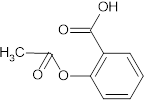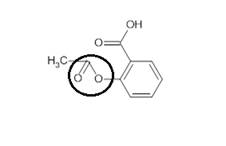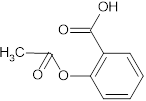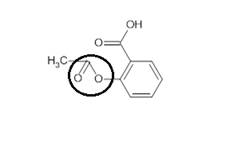
World of Chemistry
7th Edition
ISBN: 9780618562763
Author: Steven S. Zumdahl
Publisher: Houghton Mifflin College Div
expand_more
expand_more
format_list_bulleted
Question
Chapter 20, Problem 53A
Interpretation Introduction
Interpretation:
The structure of acetylsalicylic acid is to be drawn and the ester portion is to be circled.
Concept introduction:
Acetylsalicylic acid is also known as aspirin. It is used as medicine for pain relief.
Expert Solution & Answer
Answer to Problem 53A
Structure of acetylsalicylic acid:

Circle showing ester group:

It is synthesized from acetic acid and salicylic acid.
Explanation of Solution
Structure of acetylsalicylic acid:

Circle showing ester group:

It is synthesized when alcoholic portion of salicylic acid is reacted with acetic acid.
Acid and alcohol combines to form ester as:

Acetic acid (acid) salicylic acid (alcohol)
Conclusion
Thus, acetic acid and salicylic acid combine to form acetylsalicylic acid.
Chapter 20 Solutions
World of Chemistry
Ch. 20.1 - Prob. 1RQCh. 20.1 - Prob. 2RQCh. 20.1 - Prob. 3RQCh. 20.1 - Prob. 4RQCh. 20.1 - Prob. 5RQCh. 20.1 - Prob. 6RQCh. 20.1 - Prob. 7RQCh. 20.1 - Prob. 8RQCh. 20.2 - Prob. 1RQCh. 20.2 - Prob. 2RQ
Ch. 20.2 - Prob. 3RQCh. 20.2 - Prob. 4RQCh. 20.2 - Prob. 5RQCh. 20.2 - Prob. 6RQCh. 20.3 - Prob. 1RQCh. 20.3 - Prob. 2RQCh. 20.3 - Prob. 3RQCh. 20.3 - Prob. 4RQCh. 20.3 - Prob. 5RQCh. 20.4 - Prob. 1RQCh. 20.4 - Prob. 2RQCh. 20.4 - Prob. 3RQCh. 20.4 - Prob. 4RQCh. 20.4 - Prob. 5RQCh. 20 - Prob. 1ACh. 20 - Prob. 2ACh. 20 - Prob. 3ACh. 20 - Prob. 4ACh. 20 - Prob. 5ACh. 20 - Prob. 6ACh. 20 - Prob. 7ACh. 20 - Prob. 8ACh. 20 - Prob. 9ACh. 20 - Prob. 10ACh. 20 - Prob. 11ACh. 20 - Prob. 12ACh. 20 - Prob. 13ACh. 20 - Prob. 14ACh. 20 - Prob. 15ACh. 20 - Prob. 16ACh. 20 - Prob. 17ACh. 20 - Prob. 18ACh. 20 - Prob. 19ACh. 20 - Prob. 20ACh. 20 - Prob. 21ACh. 20 - Prob. 22ACh. 20 - Prob. 23ACh. 20 - Prob. 24ACh. 20 - Prob. 25ACh. 20 - Prob. 26ACh. 20 - Prob. 27ACh. 20 - Prob. 28ACh. 20 - Prob. 29ACh. 20 - Prob. 30ACh. 20 - Prob. 31ACh. 20 - Prob. 32ACh. 20 - Prob. 33ACh. 20 - Prob. 34ACh. 20 - Prob. 35ACh. 20 - Prob. 36ACh. 20 - Prob. 37ACh. 20 - Prob. 38ACh. 20 - Prob. 39ACh. 20 - Prob. 40ACh. 20 - Prob. 41ACh. 20 - Prob. 42ACh. 20 - Prob. 43ACh. 20 - Prob. 44ACh. 20 - Prob. 45ACh. 20 - Prob. 46ACh. 20 - Prob. 47ACh. 20 - Prob. 48ACh. 20 - Prob. 49ACh. 20 - Prob. 50ACh. 20 - Prob. 51ACh. 20 - Prob. 52ACh. 20 - Prob. 53ACh. 20 - Prob. 54ACh. 20 - Prob. 55ACh. 20 - Prob. 56ACh. 20 - Prob. 57ACh. 20 - Prob. 58ACh. 20 - Prob. 59ACh. 20 - Prob. 60ACh. 20 - Prob. 61ACh. 20 - Prob. 62ACh. 20 - Prob. 63ACh. 20 - Prob. 64ACh. 20 - Prob. 65ACh. 20 - Prob. 66ACh. 20 - Prob. 67ACh. 20 - Prob. 68ACh. 20 - Prob. 1STPCh. 20 - Prob. 2STPCh. 20 - Prob. 3STPCh. 20 - Prob. 4STPCh. 20 - Prob. 5STPCh. 20 - Prob. 6STPCh. 20 - Prob. 7STPCh. 20 - Prob. 8STPCh. 20 - Prob. 9STP
Knowledge Booster
Similar questions
- Q2: We would not expect the following primary alkyl halide to go through an SN1 reaction. However, it can go through an SN1 mechanism. Explain why. Hint: Think about what happens when the leaving group leaves. CI NaO EtOH H བྱིས་ Harrow_forwardI performed this experiment, but I'm so confused. How do I find the first two blank columns using the data provided. What is the [I^-] mol/L and [S2O8^-2] mol/L. How do I find this? Please help!arrow_forwardExample 3 A molecule is achiral if it has a plane of symmetry in any conformation. The given conformation of 2,3-dibromobutane below does not have a plane of symmetry. Will rotation around the C2-C3 bond form a conformation with a plane of symmetry? Draw the conformation to find out. DIY: Do the same for: H3C Brill rotate H CH3 OH HO Brarrow_forward
- 120 100 20 20 bound drug/free drug (%) 60 40 60 80 80 0 0 Scatchard Plot of Drug Binding 20 20 40 60 80 100 120 bound drug (nM)arrow_forwardUsing diethylmalonate and benzyl bromide as your only as your only source of carbon, propose a synthesis for the following compound.arrow_forwardplease helparrow_forward
- What is the difference between (+)-(S)-methamphetamine and (-)-(R)-methamphetamine versus levo-methamphetamine and dextro-methamphetamine, D-methamphetamine, and L-methamphetamine, and N-methamphetamine? Please use scholarly sources and in-text citations.arrow_forwardanswer all the questions with explanationarrow_forwardPlease draw a mechanism don't write sentarrow_forward
- From this COZY spectrum, how do you know which protons are next to each other?arrow_forward5. A buffer consists of 0.45 M NH, and 0.25 M NH-CI (PK of NH 474) Calculate the pH of the butter. Ans: 9.52 BAS PH-9.26 +10g (10.95)) 14-4.59 PH=4.52 6. To 500 ml of the buffer on #5 a 0.20 g of sample of NaOH was added a Write the net ionic equation for the reaction which occurs b. Should the pH of the solution increase or decrease sightly? Calculate the pH of the buffer after the addition Ans: 9.54arrow_forwardExplain the inductive effect (+I and -I) in benzene derivatives.arrow_forward
arrow_back_ios
SEE MORE QUESTIONS
arrow_forward_ios
Recommended textbooks for you
 ChemistryChemistryISBN:9781305957404Author:Steven S. Zumdahl, Susan A. Zumdahl, Donald J. DeCostePublisher:Cengage Learning
ChemistryChemistryISBN:9781305957404Author:Steven S. Zumdahl, Susan A. Zumdahl, Donald J. DeCostePublisher:Cengage Learning ChemistryChemistryISBN:9781259911156Author:Raymond Chang Dr., Jason Overby ProfessorPublisher:McGraw-Hill Education
ChemistryChemistryISBN:9781259911156Author:Raymond Chang Dr., Jason Overby ProfessorPublisher:McGraw-Hill Education Principles of Instrumental AnalysisChemistryISBN:9781305577213Author:Douglas A. Skoog, F. James Holler, Stanley R. CrouchPublisher:Cengage Learning
Principles of Instrumental AnalysisChemistryISBN:9781305577213Author:Douglas A. Skoog, F. James Holler, Stanley R. CrouchPublisher:Cengage Learning Organic ChemistryChemistryISBN:9780078021558Author:Janice Gorzynski Smith Dr.Publisher:McGraw-Hill Education
Organic ChemistryChemistryISBN:9780078021558Author:Janice Gorzynski Smith Dr.Publisher:McGraw-Hill Education Chemistry: Principles and ReactionsChemistryISBN:9781305079373Author:William L. Masterton, Cecile N. HurleyPublisher:Cengage Learning
Chemistry: Principles and ReactionsChemistryISBN:9781305079373Author:William L. Masterton, Cecile N. HurleyPublisher:Cengage Learning Elementary Principles of Chemical Processes, Bind...ChemistryISBN:9781118431221Author:Richard M. Felder, Ronald W. Rousseau, Lisa G. BullardPublisher:WILEY
Elementary Principles of Chemical Processes, Bind...ChemistryISBN:9781118431221Author:Richard M. Felder, Ronald W. Rousseau, Lisa G. BullardPublisher:WILEY

Chemistry
Chemistry
ISBN:9781305957404
Author:Steven S. Zumdahl, Susan A. Zumdahl, Donald J. DeCoste
Publisher:Cengage Learning

Chemistry
Chemistry
ISBN:9781259911156
Author:Raymond Chang Dr., Jason Overby Professor
Publisher:McGraw-Hill Education

Principles of Instrumental Analysis
Chemistry
ISBN:9781305577213
Author:Douglas A. Skoog, F. James Holler, Stanley R. Crouch
Publisher:Cengage Learning

Organic Chemistry
Chemistry
ISBN:9780078021558
Author:Janice Gorzynski Smith Dr.
Publisher:McGraw-Hill Education

Chemistry: Principles and Reactions
Chemistry
ISBN:9781305079373
Author:William L. Masterton, Cecile N. Hurley
Publisher:Cengage Learning

Elementary Principles of Chemical Processes, Bind...
Chemistry
ISBN:9781118431221
Author:Richard M. Felder, Ronald W. Rousseau, Lisa G. Bullard
Publisher:WILEY